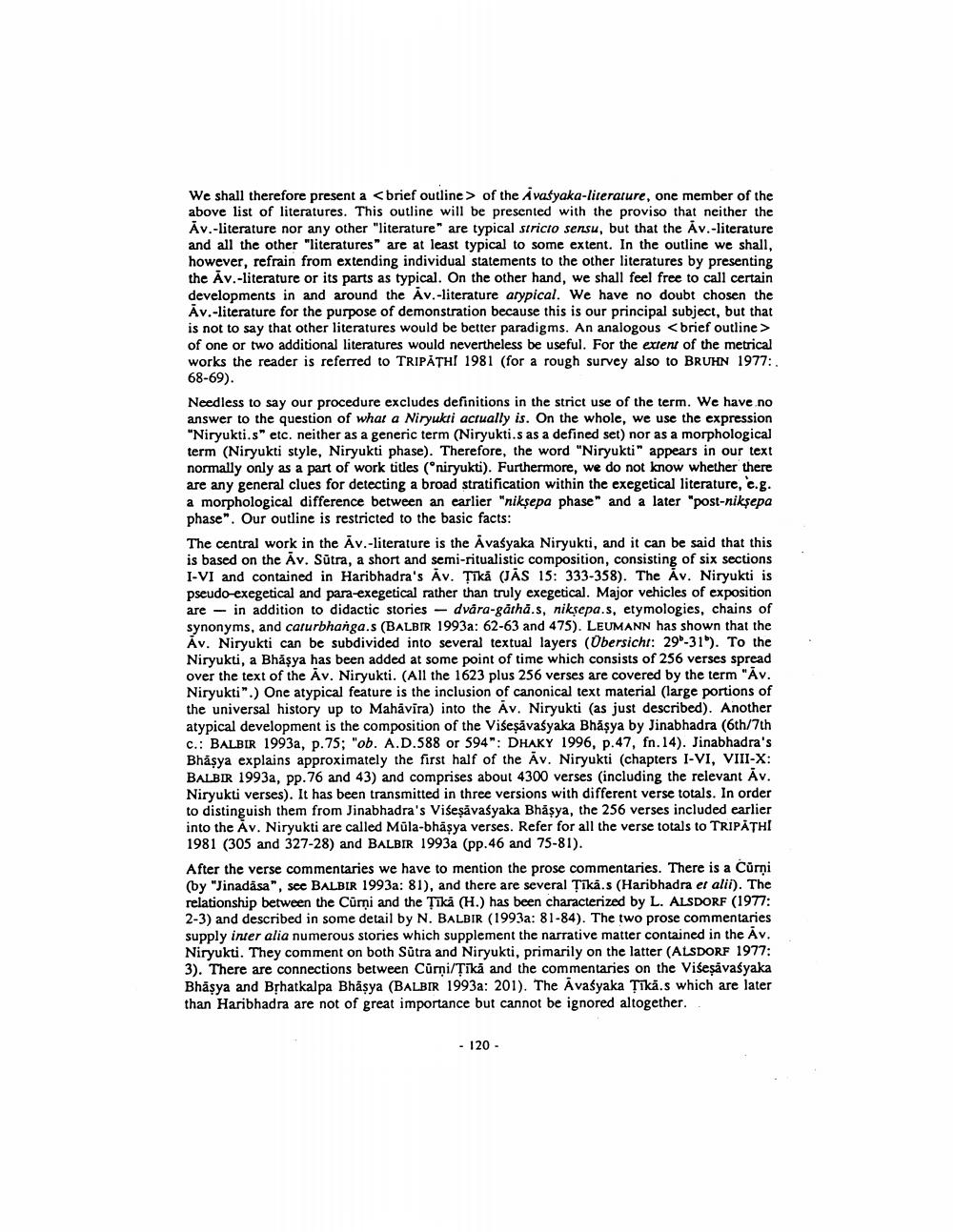Book Title: Bibliography Of Studies Connected With Avasyaka Commentaries Author(s): Klaus Bruhn Publisher: Klaus Bruhn View full book textPage 2
________________ We shall therefore present a <brief outline of the A vafyaka-literature, one member of the above list of literatures. This outline will be presented with the proviso that neither the Av.-literature nor any other "literature" are typical stricto sensu, but that the Av.-literature and all the other "literatures" are at least typical to some extent. In the outline we shall, however, refrain from extending individual statements to the other literatures by presenting the Av.-literature or its parts as typical. On the other hand, we shall feel free to call certain developments in and around the Av.-literature arypical. We have no doubt chosen the Āv.-literature for the purpose of demonstration because this is our principal subject, but that is not to say that other literatures would be better paradigms. An analogous <brief outline > of one or two additional literatures would nevertheless be useful. For the extent of the metrical works the reader is referred to TRIPATHI 1981 (for a rough survey also to BRUHN 1977:. 68-69). Needless to say our procedure excludes definitions in the strict use of the term. We have no answer to the question of what a Niryukti actually is. On the whole, we use the expression "Niryukti.s" etc. neither as a generic term (Niryukti.s as a defined set) nor as a morphological term (Niryukti style, Niryukti phase). Therefore, the word "Niryukti" appears in our text normally only as a part of work titles (Oniryukti). Furthermore, we do not know whether there are any general clues for detecting a broad stratification within the exegetical literature, c.g. a morphological difference between an earlier "niksepa phase" and a later "post-niksepa phase". Our outline is restricted to the basic facts: The central work in the Av.-literature is the Avasyaka Niryukti, and it can be said that this is based on the Āv. Sūtra, a short and semi-ritualistic composition, consisting of six sections I-VI and contained in Haribhadra's Av. Tikå (JĀS 15: 333-358). The Av. Niryukti is pseudo-exegetical and para-exegetical rather than truly exegetical. Major vehicles of exposition are -- in addition to didactic stories - dvara-gåtha.s, nikscpa.s, etymologies, chains of synonyms, and caturbhanga.s (BALBIR 1993a: 62-63 and 475). LEUMANN has shown that the Av. Niryukti can be subdivided into several textual layers (Obersicht: 290-31'). To the Niryukti, a Bhăşya has been added at some point of time which consists of 256 verses spread over the text of the Av. Niryukti. (All the 1623 plus 256 verses are covered by the term "Av. Niryukti".) One atypical feature is the inclusion of canonical text material (large portions of the universal history up to Mahavira) into the Av. Niryukti (as just described). Another atypical development is the composition of the Visesavasyaka Bhaşya by Jinabhadra (6th/7th C.: BALBIR 1993a, p.75; "ob. A.D.588 or 594": DHAKY 1996, p.47, fn. 14). Jinabhadra's Bhășya explains approximately the first half of the Av. Niryukti (chapters I-VI, VIII-X: BALBIR 1993a, pp.76 and 43) and comprises about 4300 verses (including the relevant Av. Niryukti verses). It has been transmitted in three versions with different verse totals. In order to distinguish them from Jinabhadra's Visesavaśyaka Bhăşya, the 256 verses included earlier into the Av. Niryukti are called Müla-bhäşya verses. Refer for all the verse totals to TRIPATHI 1981 (305 and 327-28) and BALBIR 1993a (pp.46 and 75-81). After the verse commentaries we have to mention the prose commentaries. There is a Cūrni (by "Jinadasa", sec BALDIR 1993a: 81), and there are several Țika.s (Haribhadra et alii). The relationship between the Cümi and the Tká (H.) has been characterized by L. ALSDORF (1977: 2-3) and described in some detail by N. BALBIR (1993a: 81-84). The two prose commentaries supply inter alia numerous stories which supplement the narrative matter contained in the Av. Niryukti. They comment on both Sutra and Niryukti, primarily on the latter (ALSDORF 1977: 3). There are connections between Curņi/Tika and the commentaries on the Visesavaśyaka Bhāşya and Bșhatkalpa Bhasya (BALBIR 1993a: 201). The Avaśyaka Tika.s which are later than Haribhadra are not of great importance but cannot be ignored altogether. - 120 -Page Navigation
1 2 3 4 5 6 7 8 9 10 11 12 13 14 15 16 17 18
